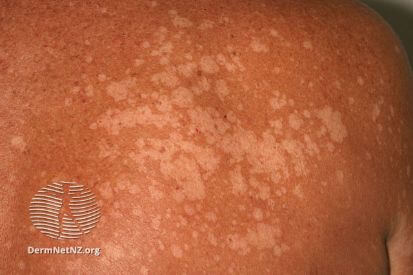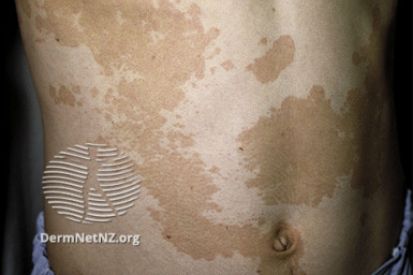Tinea Versicolor
The dermatologists at Dermatology Affiliates treat Tinea Versicolor with specialized creams, shampoos, or pills that kill the fungus. They might recommend a stronger medication if the infection is severe. Scheduling your skin consultation can help you and your dermatologist determine the best course of treatment for your diagnosis.
Following your dermatologist's advice for the best results will lead you to accomplishing your healthy skin goals.
Examples of Tinea Versicolor




What are the Symptoms of Tinea Versicolor?
- Patches may be pink, tan, or brown.
- Can merge to form larger areas.
- Tinea versicolor is more noticeable after sun exposure because the fungus inhibits the normal tanning response.
What Causes Tinea Versicolor?
- Tinea versicolor is caused by an overgrowth of the yeast-like fungus (Malassezia) on the skin.
- The fungus disrupts normal pigmentation, leading to the development of discolored patches on the skin.
- Factors like heat, humidity, and oily skin can contribute to the overgrowth of Malassezia.
Tips on How to Prevent Tinea Versicolor
Tips for preventing tinea versicolor that you can try while you wait to see a dermatologist include:
- Avoid excessive heat and humidity whenever possible.
- Keep sun exposure to a minimum, and avoid other elements that can darken your skin such as tanning beds, as this can enhance discoloration.
- Wear clothing that is loose, breathable, or made of wicking materials.
- Avoid skin products that are oily, ideally choosing oil-free or non-comedogenic options.
- Use anti-fungal shampoos and creams. When using creams, apply to clean and dry skin according to package instructions.
Tinea Versicolor FAQs
Dermatologists often diagnose Tinea Versicolor by examining the affected skin and may use a Wood's lamp for better visibility. If you notice persistent discoloration or changes in your skin, consult a dermatologist.
Recurrence is possible, especially in warm and humid environments. Dermatologists may recommend antifungal shampoos or other preventive measures to minimize the risk of recurrence.
Yes, Tinea Versicolor can affect facial skin. Dermatologists may recommend specialized treatments for the face, such as antifungal creams or washes designed for sensitive areas.
Sun exposure can worsen Tinea Versicolor. Dermatologists often advise avoiding prolonged sun exposure and may recommend specific sunscreens or protective measures to prevent exacerbation.
Treatment Options for Tinea Versicolor
If tinea versicolor is diagnosed, dermatologists may prescribe oral antifungal medications. It's essential to follow the prescribed treatment regimen consistently to ensure effective resolution of the infection. To create your personalized tinea versicolor maintenance plan, schedule a consultation with Pinnacle Dermatology.
Featured Blogs

- General Dermatology
As the U.S. population ages, the number of Americans who suffer from skin diseases will continue to rise, according to the American Academy of Dermatology (AAD).
Read More
- Skin Care
- Cosmetic Treatments
I had my second Elos Sublative RF Microneedling Treatment (which is an amazing new treatment we’ve added for addressing fine lines, wrinkles, acne scars and texture).
Read More
- Skin Care
- Botox
- Cosmetic Treatments
Retiniods are proven to combat fine lines, brown spots and improve texture, “tret” has been shown to enhance collagen production, even skin tone, unclog pores, and smooth skin texture.
Read MoreFeatured Products
Check your local office for current stock!
Check your local office for current stock!


